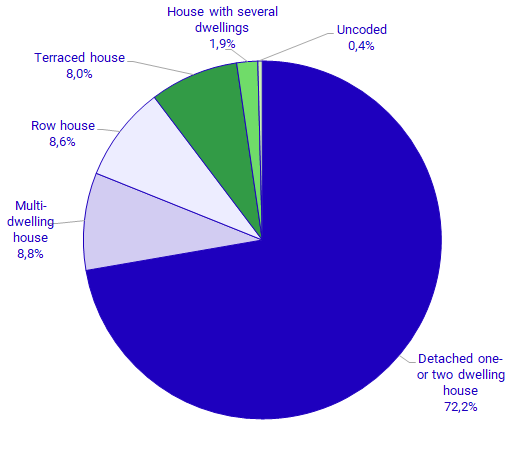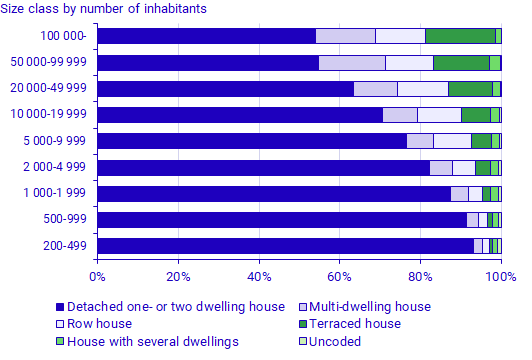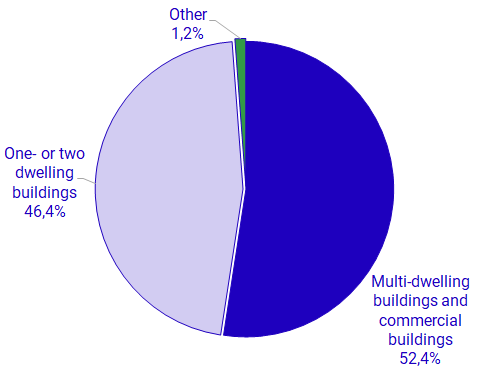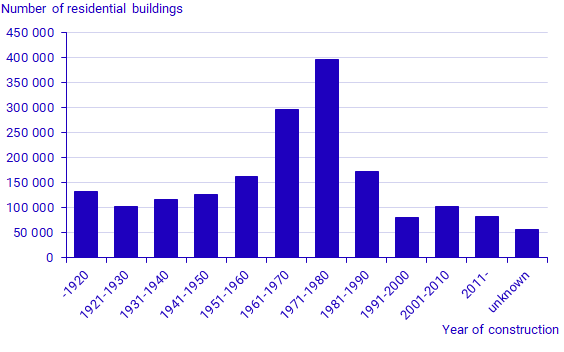Localities 2020:
Detached one- or two-dwelling houses most common in localities
Statistical news from Statistics Sweden 2022-03-31 8.00
The most common type of dwelling in localities is detached one- or two-dwelling houses. They make up 72 percent of the total number of dwellings in localities. At the same time, more than half of the population of localities reside in multi-dwelling buildings.
Detached one- or two-dwelling houses make up 72 percent of the total number of dwellings in localities. Other types of small buildings containing dwellings such as terraced houses and row houses make up almost 19 percent of dwellings. Multi-dwelling houses make up 9 percent of the total number of dwellings in localities.
Residential buildings in localities, according to number by type of dwelling. Percentage, 31/12/2020

Source: Statistics Sweden
The percentage of detached one- or two-dwelling houses is clearly linked to the number of inhabitants of the locality. In localities with fewer than 500 inhabitants, detached one- or two-dwelling houses make up 93 percent of all residential buildings on average. That percentage decreases as the size of the locality increases. In localities with more than 100,000 inhabitants, 54 percent of all residential buildings are detached one- or two-dwelling houses.
Other types of single-dwelling houses, such as terraced houses and row houses, are more common in larger localities. In the largest localities with more than 100,000 inhabitants, they make up 31 percent of all residential buildings. In the smallest localities, with fewer than 500 inhabitants, they make up 4 percent of all residential buildings.
The proportion of multi-dwelling houses is greatest in localities with a population of 50,000–100,000 inhabitants. There, they make up 17 percent of all residential buildings. In localities with more than 100,000 inhabitants, multi-dwelling houses make up 15 percent of residential buildings.

Source: Statistics Sweden
More than half reside in multi-dwelling buildings
More than half of the population of localities reside in multi-dwelling buildings. 46 percent live in single-dwelling or small multi-unit buildings. Stockholm County has the highest proportion of urban population (65 percent) residing in multi-dwelling buildings. The lowest proportion, 35 percent, is in Halland County. This is followed by Dalarna and Blekinge, both of which have 38 percent residing in multi-dwelling buildings in localities.

5 percent of the residential buildings of localities are new
Out of the total number of residential buildings in localities, 38 percent were built during the period 1961–1980. The high proportion is explained by the ‘1965–1975 Million-home Construction Programme’, when a great number of homes were built in Sweden. The background was a decision by the Riksdag in 1965, with the objective of building one million new homes in a short space of time to solve the acute housing shortage.
Homes built in the past decade make up just shy of 5 percent of the total number of residential buildings in localities.

Source: Statistics Sweden
More statistics on localities
Statistics on dwellings and buildings are merely a part of all the statistics produced by Statistics Sweden on localities. The latest report on Sweden’s localities also contains information on population, people in gainful employment and land area. Statistics are also available there on small localities and areas that are classed neither as localities nor small localities.
- “The report provides numerous examples of how the statistics can be interpreted and used in analyses on population and settlement structures. It is a good point of entry into Statistics Sweden’s combined statistics on localities. For users who would like more information, lots can be found in Statistics Sweden’s statistical database,” comments Karin Hedeklint, head of Statistics Sweden’s statistics on localities and small localities.
Definitions and explanations
In Statistics Sweden’s statistics, a locality is a settlement with at least 200 registered inhabitants that is densely built. Statistics Sweden defines the localities geographically and then calculates statistics for them. The density of the settlement is measured using digital maps from Lantmäteriet, the Swedish Land Registration Authority, with information on buildings, properties, roads and land. The distance between the buildings of the localities varies depending on several factors, including the number of registered people and employees in the various parts of the locality. The furthest permitted distance is 500 metres. Information on population and employees is retrieved from Statistics Sweden’s registers, which are combined with address data.
In the statistics, the term “statistical locality” is used to indicate that the statistics are based on a classification of localities, for which register data and statistics form the basis. Statistics Sweden’s localities can therefore differ from how other parts of society define and delimit localities in Sweden.
Classification of buildings and dwellings follows coding according to purpose in the Real Property Register, building part (Lantmäteriet).
- detached one- or two dwelling house: House containing one or two dwellings that is not connected to another house.
- Row house: Two or more one-dwelling houses, connected by a garage, storeroom or similar. Each dwelling is on its own property. Semi-detached houses are also classified as linked houses.
- Terraced house: At least three one-dwelling houses in a row. The housing components are directly connected to each other and each dwelling is on its own property.
- House with several dwellings: Small buildings with several dwellings on the same property.
- Multi-dwelling houses: Buildings that contain at least three dwellings. Can contain offices, stores, hotels, restaurants and so on. At least 50 percent must consist of dwellings.
Maps and geodata
Geodata for localities Open data for localities
Statistics Sweden’s map search tool for regional divisions: SCB Regina Web Map
Publication
Feel free to use the facts from this statistical news but remember to state Source: Statistics Sweden.
